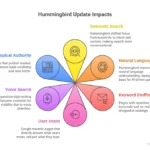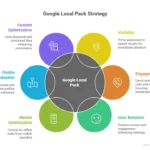Google’s RankBrain algorithm marked the first major use of artificial intelligence in Google Search. It helps Google understand the intent behind queries it has never seen before.
RankBrain is part of Google’s core algorithm and works as a machine learning system. It studies patterns in search data, learns how people interact with results, and improves rankings based on that learning.
When it was first introduced, RankBrain affected a large portion of searches. According to Google, it became the third most important ranking factor, after content and backlinks.
In this article, we will explore what RankBrain is, how it works, and how to optimize your website to perform better under this AI-driven update.

The Main Goal of RankBrain
The main goal of Google RankBrain is to understand user intent and improve search result relevance using artificial intelligence. Unlike traditional algorithms, RankBrain doesn’t just follow rules; it learns from data and adapts over time.
RankBrain focuses on queries Google has never seen before. Estimates suggest that 15% of daily searches are completely new. RankBrain helps Google provide accurate results even for these unique searches.
The algorithm converts words into mathematical vectors — called word embeddings — to measure the relationship between terms. For example, it can understand that “best SEO course online” and “top digital marketing training” are closely related, even if they use different words.
Its main goals:
- Improve relevance: Match search results to user intent, not just keywords.
- Handle complex queries: Solve multi-word, ambiguous, or conversational searches.
- Learn over time: RankBrain adapts based on how users interact with search results, refining rankings continuously.
RankBrain marked a shift toward AI-powered SEO, laying the foundation for future machine learning updates like BERT.
How RankBrain Works
Google RankBrain works by using machine learning to understand search queries and improve results. It focuses on meaning, context, and user behavior rather than exact keyword matching.
1. Word Vectors and Semantic Understanding
RankBrain converts words into mathematical representations called vectors. These vectors capture relationships between words and phrases. For example:
- “Digital marketing course” and “online SEO training” are treated as related concepts, even if they don’t share exact words.
This allows Google to handle synonyms, abbreviations, and new phrases effectively.
2. Learning from User Behavior
RankBrain studies how users interact with search results. Key factors include:
- Click-through rate (CTR): How often users click a result.
- Dwell time: How long users stay on a page.
- Bounce rate: Whether users return to search quickly.
This feedback loop helps Google adjust rankings dynamically. Pages that satisfy intent are rewarded over those that just use keywords.
3. Handling Unseen Queries
About 15% of searches every day are completely new. RankBrain predicts the best results for these queries using learned patterns from similar searches.
For example, if someone searches “best AI tools for SEO in India” and it’s a new query, RankBrain finds pages relevant to AI tools, SEO, and India — even if no page contains the exact phrase.
4. Integration with Core Algorithm
RankBrain works alongside other ranking factors, like backlinks, content relevance, and EEAT. It does not replace these factors but enhances their effectiveness by interpreting intent and context.
5. Speed and Scalability
Machine learning allows RankBrain to process billions of queries quickly, learning patterns automatically. This makes Google faster and more intelligent in delivering results.
Impact on SEO
RankBrain significantly changed how SEO works. It shifted the focus from exact keywords to user intent, content relevance, and engagement signals.
1. Focus on Intent Over Keywords
Before RankBrain, websites could rank by using exact-match keywords repeatedly. Now, Google understands the meaning behind queries.
Example: Instead of repeating “SEO course online,” a page covering “digital marketing learning paths, SEO tutorials, and advanced SEO strategies” can rank better because it satisfies user intent.
2. Importance of Content Quality
RankBrain favors content that solves user problems. Pages that provide clear answers, structured information, and practical value perform better.
Studies show that pages with higher dwell time and lower bounce rates often rank higher under RankBrain’s influence. For instance, content that keeps users reading for 3–5 minutes signals relevance and value.
3. Rise of Long-Tail and Conversational Queries
RankBrain handles long-tail queries effectively, which make up over 70% of search traffic.
Example: Queries like “how to track website ranking using AI tools” get more accurate results because RankBrain interprets the full intent.
4. Enhanced User Experience Signals
RankBrain uses engagement metrics such as click-through rate (CTR), dwell time, and pogo-sticking (returning to search quickly). Pages that meet user expectations are rewarded, even if they have fewer backlinks or lower keyword density.
5. Alignment with EEAT and Topical Authority
RankBrain works in combination with EEAT principles. Websites that demonstrate expertise, authority, and trustworthiness in a specific niche rank better. Topical authority across multiple related pages also improves visibility.
6. Overall SEO Shift
The impact of RankBrain made SEO more user-centric:
- Focus on solving problems, not keyword density.
- Optimize content for long-tail and conversational queries.
- Enhance user engagement with clear, structured, and helpful content.
In short, RankBrain transformed SEO from a technical keyword game to a human-centric content strategy.
How to Optimize for RankBrain
Optimizing for RankBrain focuses on intent, engagement, and topic depth. Since it uses AI to understand queries, content must be clear, relevant, and helpful.
1. Understand User Intent
Analyze the purpose behind each query. Users typically search for:
- Informational content: “What is RankBrain?”
- Transactional content: “Best AI SEO tools to buy”
- Navigational content: “HubSpot official website”
Matching content to the correct intent improves CTR and dwell time, which RankBrain monitors.
2. Use Natural and Conversational Language
RankBrain favors human-friendly language over exact keyword repetition. Write in a way people speak or type in search boxes.
Example: Instead of “best SEO course,” write:
- “Which online SEO courses are best for beginners?”
- “Top digital marketing training programs to boost your career”
3. Cover Complete Topics
RankBrain values semantic richness. Content should cover a topic thoroughly, including related subtopics and FAQs.
Example for an SEO article:
- Basics of SEO
- On-page and off-page optimization
- Tools and techniques
- Common mistakes and solutions
This increases information gain, helping pages satisfy search intent fully.
4. Optimize Engagement Signals
RankBrain monitors how users interact with content. To optimize:
- Improve readability with short sentences and clear headings.
- Add visual aids like charts or images.
- Use internal links to related topics.
- Reduce page load time to enhance user experience.
5. Build EEAT and Topical Authority
RankBrain rewards authoritative content. Boost credibility by:
- Adding author bios with expertise
- Citing credible sources and data
- Publishing multiple articles around the same niche
- Earning backlinks from relevant and trusted sites
6. Use Structured Data and Semantic HTML
RankBrain benefits from structured content. Use proper headings (H1-H3), <main>, <article>, <section>, and schema markup for:
- FAQ
- How-to guides
- Product or course listings
This helps Google understand content meaning and improves chances for rich snippets.
Key Takeaways
Google RankBrain brought AI and machine learning into search, transforming SEO from keyword-focused to intent-focused and user-centered.
- RankBrain understands user intent.
It interprets queries based on meaning, not just words. - Machine learning adapts rankings.
RankBrain learns from user behavior like clicks, dwell time, and pogo-sticking to improve results. - Keyword stuffing is obsolete.
Pages with relevant, high-quality content rank better than pages repeating keywords. - Long-tail and conversational queries are crucial.
Over 70% of searches are now long-tail or unique. Writing naturally helps capture these queries. - Engagement signals matter.
CTR, dwell time, and user satisfaction influence rankings. - Topical authority and EEAT are rewarded.
Content from experts or authoritative sites ranks higher and builds trust.
In short, RankBrain shifted SEO to a human-first, AI-enhanced model. Optimizing for RankBrain means focusing on user intent, engagement, and comprehensive topic coverage.

